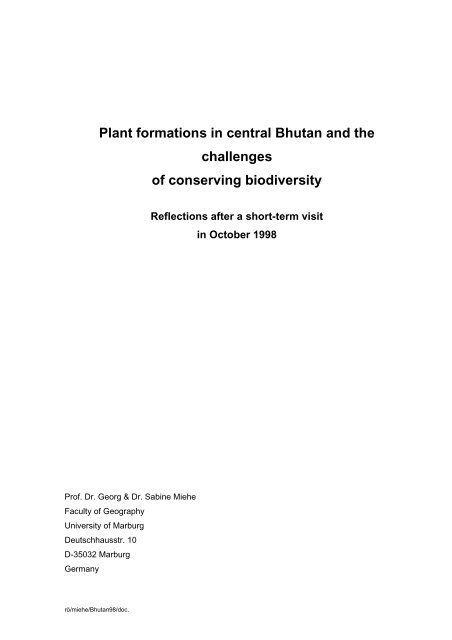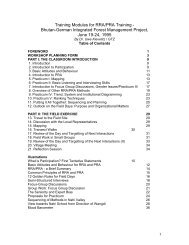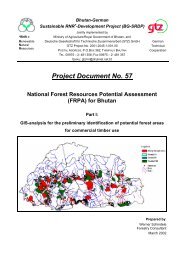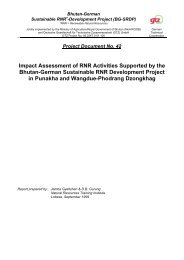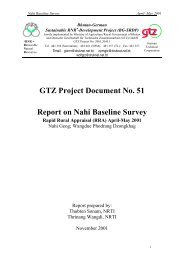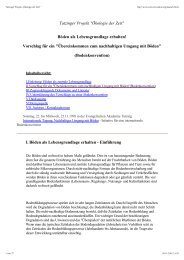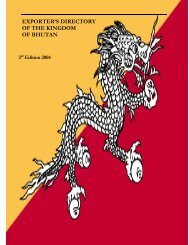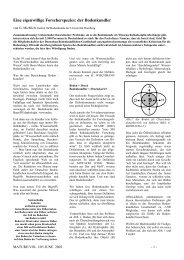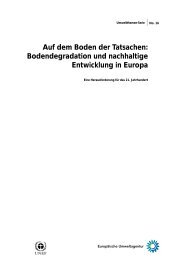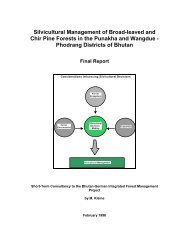Plant formations in central Bhutan and the challenges of conserving biodiversity
Plant formations in central Bhutan and the challenges of conserving ...
Plant formations in central Bhutan and the challenges of conserving ...
Create successful ePaper yourself
Turn your PDF publications into a flip-book with our unique Google optimized e-Paper software.
10broad-leaved trees (birches, maple, Sorbus) are usually less numerous. The ground layer isdom<strong>in</strong>ated by mosses <strong>and</strong> liverworts.Prist<strong>in</strong>e, mature upper montane coniferous forests are very poor <strong>in</strong> flower<strong>in</strong>g plant species.Natural die-back <strong>of</strong> <strong>the</strong> canopy trees <strong>in</strong>itiates phases <strong>of</strong> higher floristic diversity: lightdem<strong>and</strong><strong>in</strong>gbirches, bamboo, Rhododendron spp., herbs but also <strong>the</strong> canopy trees<strong>the</strong>mselves are able to regenerate <strong>in</strong> <strong>the</strong> light <strong>of</strong> <strong>the</strong> forest gaps. Small gaps created byartificial clear<strong>in</strong>g have <strong>the</strong> same effect.Thus <strong>the</strong> open<strong>in</strong>g <strong>of</strong> <strong>the</strong> upper montane forests has a positive effect on floristic diversity.Especially <strong>Bhutan</strong>'s most showy woody plants, <strong>the</strong> rhododendrons, are richest <strong>in</strong> species <strong>in</strong>light habitats such as along trails, on forest edges <strong>and</strong> <strong>in</strong> gaps. In prist<strong>in</strong>e forests this variety<strong>of</strong> rhododendrons grow is highest on steep rocky slopes where <strong>the</strong> tree canopy is naturallyopen. In closed undisturbed forests very few shade-tolerant or even shade-dem<strong>and</strong><strong>in</strong>gspecies occur.What do we want? The enrichment uf upper montane forests with showy plants is desirable,especially <strong>in</strong> areas favoured for eco-tourism. But, where trees are cut <strong>the</strong>re are people, <strong>and</strong>where people live <strong>the</strong>re are cattle......On <strong>the</strong> first glimpse, graz<strong>in</strong>g <strong>of</strong> <strong>the</strong> upper montane forest <strong>in</strong>creases <strong>the</strong> floristic diversity aswell. Weedy herbs are taken up from <strong>the</strong> broad-leaved forest <strong>and</strong> alp<strong>in</strong>e ones <strong>in</strong>vade <strong>the</strong> firforests. Trampl<strong>in</strong>g damages <strong>the</strong> mossy ground layer <strong>and</strong> exposes m<strong>in</strong>eral soil which is <strong>the</strong>preferred germ<strong>in</strong>ation bed for several tree species.Brows<strong>in</strong>g, however, strongly affects <strong>the</strong> dynamics <strong>of</strong> regeneration <strong>in</strong> <strong>the</strong>se forests.Rhododendrons are <strong>in</strong>deed a valuable element <strong>of</strong> <strong>biodiversity</strong> <strong>in</strong> <strong>Bhutan</strong>, but <strong>the</strong>y arefavoured <strong>in</strong>directly by graz<strong>in</strong>g, at <strong>the</strong> expense <strong>of</strong> o<strong>the</strong>r broad-leaved understorey trees <strong>and</strong><strong>the</strong> canopy-build<strong>in</strong>g conifers. One can even regard <strong>the</strong>m as graz<strong>in</strong>g weeds! ROSSET &RINCHEN (1998) have shown <strong>in</strong> exclosure experiments to what extent <strong>the</strong> regeneration <strong>of</strong>Hemlock, fir <strong>and</strong> birches is reduced on grazed plots, <strong>in</strong> favour <strong>of</strong> Rhododendron spp.On <strong>the</strong> o<strong>the</strong>r h<strong>and</strong> Rhododendron thickets, less <strong>in</strong>tensively grazed by wild <strong>and</strong> domesticanimals, are supposed to provide shelter for <strong>the</strong> regeneration <strong>of</strong> <strong>the</strong> shade-tolerant fir(BÜRGI, RINCHEN & TSHEWANG 1992).In many grazed upper montane forests visited dur<strong>in</strong>g our excursions, <strong>the</strong>re was anovermature canopy <strong>of</strong> <strong>the</strong> conifers; <strong>the</strong> understoreys were dom<strong>in</strong>ated by bamboo,Rhododendron <strong>and</strong> Daphne bholua, but <strong>the</strong>re was a total lack <strong>of</strong> conifer regeneration. Thus<strong>the</strong> future <strong>of</strong> <strong>the</strong>se forests appears to be questionable. It is true that <strong>the</strong> upper montaneconifers live several hundreds <strong>of</strong> years (with at least 400 years <strong>the</strong> cycle <strong>of</strong> <strong>the</strong> fir is longest),thus it doesn't matter if <strong>the</strong>re is no regeneration for some decades (op.cit.). But if <strong>the</strong>re are noyounger trees at all, a long phase <strong>of</strong> pure broad-leaved forests is to be expected when <strong>the</strong>rö/miehe/<strong>Bhutan</strong>98/doc
11present conifer canopy breaks down, as it is observed on larger clear<strong>in</strong>gs (BÜRGI 1994).Clear-cut areas, once or several times burnt, favour <strong>the</strong> <strong>in</strong>vasion <strong>of</strong> bamboos, Juniperusrecurva (<strong>in</strong> <strong>the</strong> fir belt) <strong>and</strong> bracken as common secondary <strong>formations</strong>. These species aremore resistant to graz<strong>in</strong>g than <strong>the</strong> ground layer <strong>of</strong> a fir forest. Open juniper st<strong>and</strong>s withRhododendrons <strong>and</strong> a number <strong>of</strong> herbaceous plants are richer <strong>in</strong> species, structurally morediverse <strong>and</strong> provide better pasture than closed coniferous forests. On <strong>the</strong> o<strong>the</strong>r side,Hemlock, fir <strong>and</strong> spruce forests provide valuable timber <strong>and</strong> habitats for a number <strong>of</strong> wildanimals. It depends on <strong>the</strong> purpose <strong>in</strong> which direction conservation measures are to bedriven.In any case, future decisions require a more comprehensive knowledge about <strong>the</strong> function<strong>in</strong>g<strong>of</strong> <strong>the</strong> upper montane forest ecosystems: <strong>the</strong> natural turn-over <strong>of</strong> <strong>the</strong> canopy trees, <strong>the</strong>bamboo cycles (periodic spread<strong>in</strong>g <strong>and</strong> die-back), <strong>the</strong> role <strong>of</strong> Rhododendrons <strong>in</strong> <strong>the</strong>secycles, <strong>and</strong> <strong>the</strong> <strong>in</strong>fluence exerted by cattle graz<strong>in</strong>g on <strong>the</strong>se complicated patterns. Theexclosure plots set up <strong>in</strong> Bumthang are a very valuable start <strong>of</strong> <strong>the</strong> necessary monitor<strong>in</strong>g.(4) Alp<strong>in</strong>e vegetationThis is <strong>the</strong> least studied vegetation belt, even though it is reported to be <strong>of</strong> very high<strong>biodiversity</strong> value <strong>in</strong> <strong>Bhutan</strong>. Expeditions largely focussed on floristic or zoological <strong>in</strong>ventories<strong>and</strong> little on ecological questions.As far as we can state accord<strong>in</strong>g to our experience ga<strong>in</strong>ed <strong>in</strong> o<strong>the</strong>r Himalayan countries <strong>and</strong>one short visit to <strong>the</strong> lower alp<strong>in</strong>e belt S <strong>of</strong> Hurchi/Bumthang, <strong>the</strong> high <strong>biodiversity</strong> (<strong>in</strong> terms <strong>of</strong>richness <strong>in</strong> plant species) is promoted <strong>and</strong> ma<strong>in</strong>ta<strong>in</strong>ed by human's activities to a large extent.The prist<strong>in</strong>e lower alp<strong>in</strong>e vegetation consists <strong>of</strong> a ra<strong>the</strong>r monotonous Rhododendron scrub ordwarf scrub which is even poorer <strong>in</strong> species <strong>and</strong> structure than <strong>the</strong> upper montane forests.The highest diversity <strong>in</strong> <strong>the</strong> monospecific Rhododendron thickets is performed by <strong>the</strong> mosslayer <strong>and</strong> epiphytic thallophytes. Light-dem<strong>and</strong><strong>in</strong>g flower<strong>in</strong>g plants are driven <strong>in</strong>to extra-zonalhabitats <strong>of</strong> m<strong>in</strong>or extent: rocky slopes, seasonally waterlogged or dry rock plateaux, swamps<strong>and</strong> <strong>the</strong>ir marg<strong>in</strong>s. Juniper dwarf scrub may form natural mosaics with <strong>the</strong> herbaceouscommunities on sunny rock slopes, but usually fires have reduced <strong>the</strong> easily <strong>in</strong>flammablejunipers <strong>in</strong> favour <strong>of</strong> floristically rich meadow-steppe-like <strong>formations</strong>. Cutt<strong>in</strong>g or burn<strong>in</strong>g <strong>of</strong> <strong>the</strong>Rhododendrons (preferred firewood <strong>in</strong> <strong>the</strong> graz<strong>in</strong>g places) <strong>in</strong>itiates <strong>the</strong> establishment <strong>of</strong>grassl<strong>and</strong>s as well. These are ma<strong>in</strong>ly composed <strong>of</strong> Cyperaceae which are that diet preferredby Yaks. The rich variety <strong>of</strong> showy alp<strong>in</strong>e flowers, which attract diverse <strong>in</strong>sects but alsotourists, is largely due to <strong>the</strong> spread<strong>in</strong>g <strong>of</strong> unpalatable herbs ("graz<strong>in</strong>g weeds") <strong>in</strong> <strong>the</strong>serö/miehe/<strong>Bhutan</strong>98/doc
12grassl<strong>and</strong>s. They orig<strong>in</strong>ate from <strong>the</strong> free gelifluction belt or from rare naturally disturbed sites<strong>in</strong> <strong>the</strong> lower alp<strong>in</strong>e belt; thus <strong>the</strong>ir area is drastically <strong>in</strong>creased <strong>in</strong> consequence <strong>of</strong> <strong>the</strong> openhabitats <strong>of</strong>fered <strong>in</strong> <strong>the</strong> course <strong>of</strong> graz<strong>in</strong>g activities.Graz<strong>in</strong>g <strong>and</strong> fire are certa<strong>in</strong>ly tools for <strong>the</strong> floristic enrichment <strong>of</strong> <strong>the</strong> alp<strong>in</strong>e zones.What do we want?- "Museums" <strong>of</strong> <strong>the</strong> quasi-natural vegetation <strong>and</strong> refuges for <strong>the</strong> wild fauna related to it?This is certa<strong>in</strong>ly desirable <strong>in</strong> some remote areas <strong>of</strong> <strong>Bhutan</strong> where people can afford acomplete ab<strong>and</strong>onement. These will be <strong>the</strong> only places <strong>in</strong> <strong>the</strong> whole Himalayas whereundisturbed l<strong>and</strong>scapes can be seen!- Increase/ma<strong>in</strong>tenance <strong>of</strong> high <strong>biodiversity</strong> (<strong>in</strong> terms <strong>of</strong> species richness)?- Increase/ma<strong>in</strong>tenance <strong>of</strong> stability <strong>and</strong> susta<strong>in</strong>ability <strong>of</strong> high-altitude pastures <strong>and</strong>ethnobotanic resources?If conservation measures aim at <strong>the</strong> last two po<strong>in</strong>ts, <strong>the</strong> problems <strong>of</strong> lack <strong>of</strong> knowledge riseaga<strong>in</strong>:- In which environment which graz<strong>in</strong>g <strong>in</strong>tensity is still tolerable from <strong>the</strong> aspects <strong>of</strong>susta<strong>in</strong>ability <strong>and</strong> productivity?- Which levels <strong>of</strong> species richness have <strong>the</strong> susta<strong>in</strong>able pastures? Which plant speciesdisappear with <strong>in</strong>creas<strong>in</strong>g graz<strong>in</strong>g <strong>in</strong>tensity, how widespread are <strong>the</strong>ir natural habitats?Which species appear with <strong>in</strong>creas<strong>in</strong>g graz<strong>in</strong>g pressure, <strong>and</strong> what are <strong>the</strong>ir natural areas<strong>of</strong> distribution?- Which plants are collected by people <strong>in</strong> <strong>the</strong> alp<strong>in</strong>e environment? Are <strong>the</strong>se plantsgraz<strong>in</strong>g weeds or do <strong>the</strong>y belong to that group <strong>of</strong> species vanish<strong>in</strong>g with grow<strong>in</strong>g graz<strong>in</strong>gpressure, which means that <strong>the</strong>y are threatened from two sides? (First <strong>in</strong>ventoriesdeal<strong>in</strong>g with <strong>the</strong>se questions were undertaken <strong>in</strong> L<strong>in</strong>gshi area)- For which plants <strong>the</strong>re is food competition between domestic <strong>and</strong> wild herbivores?For <strong>the</strong> answer <strong>of</strong> <strong>the</strong>se questions comprehensive <strong>in</strong>ter-discipl<strong>in</strong>ary field studies are required.1.5 Conclusions: Search for solutions <strong>in</strong> <strong>the</strong> conflict between <strong>the</strong> needs <strong>of</strong>protection <strong>and</strong> exploitationThe examples <strong>of</strong> issues <strong>in</strong> <strong>biodiversity</strong> conservation given <strong>in</strong> <strong>the</strong> last paragraphs have shownthatrö/miehe/<strong>Bhutan</strong>98/doc
13- species richness is only one facet <strong>of</strong> <strong>biodiversity</strong>- a decl<strong>in</strong>e <strong>in</strong> species richness does not necessarily correlate with <strong>in</strong>creas<strong>in</strong>g degrees <strong>of</strong>human pressure: depend<strong>in</strong>g on <strong>the</strong> level <strong>of</strong> natural species richness, <strong>the</strong> relation mightbe <strong>in</strong>verse (examples: upper montane/lower alp<strong>in</strong>e ecosystems)- <strong>the</strong> absolute number <strong>of</strong> species is ecologically, <strong>and</strong> also from <strong>the</strong> conservation po<strong>in</strong>t <strong>of</strong>view, less important than <strong>the</strong> <strong>in</strong>formation, which species are present.Thus, <strong>the</strong> <strong>in</strong>crease <strong>in</strong> species numbers is not <strong>in</strong> any case desirable. Cattle graz<strong>in</strong>g effects <strong>the</strong><strong>in</strong>troduction <strong>of</strong> alien species to any type <strong>of</strong> forest or alp<strong>in</strong>e formation. It is still unknwon whichspecies might be pushed away by <strong>the</strong> <strong>in</strong>troduced ones. Fur<strong>the</strong>rmore, <strong>the</strong> <strong>in</strong>fluence <strong>of</strong> graz<strong>in</strong>gon <strong>the</strong> regeneration <strong>of</strong> different tree species is still <strong>in</strong>sufficiently known. In some uppermontane <strong>and</strong> alp<strong>in</strong>e areas, <strong>the</strong> cont<strong>in</strong>uation <strong>of</strong> extensive graz<strong>in</strong>g might be a precondition for<strong>the</strong> ma<strong>in</strong>tenance <strong>of</strong> both villagers' subsistence economy <strong>and</strong> diverse cultural l<strong>and</strong>scapes rich<strong>in</strong> medical plants or attractive for tourism. 3For most forest ecosystems, however, <strong>the</strong> complete separation <strong>of</strong> forest <strong>and</strong> pastureappears, <strong>in</strong> <strong>the</strong> long run, to be <strong>the</strong> only reasonable way out <strong>of</strong> <strong>the</strong> conflict between <strong>the</strong> needs<strong>of</strong> pastoralism, multiple forest utilisation <strong>and</strong> <strong>biodiversity</strong> conservation.Before this is feasible, <strong>the</strong> fragmentation <strong>of</strong> dist<strong>in</strong>ct watershed areas <strong>in</strong>to compartments <strong>of</strong>different focusses <strong>and</strong> <strong>in</strong>tensities <strong>of</strong> RNR utilisation is a reasonable compromise, as long aseach forest type is excluded from human <strong>in</strong>fluence <strong>in</strong> selected areas. In this way, possiblespecies endangered by over-utilization can be preserved, <strong>and</strong> a variety <strong>of</strong> more or lesshuman-<strong>in</strong>fluenced l<strong>and</strong>scapes can be created or ma<strong>in</strong>ta<strong>in</strong>ed (= high diversity <strong>of</strong> l<strong>and</strong>scapesas ano<strong>the</strong>r aspect <strong>of</strong> <strong>biodiversity</strong>).In <strong>the</strong> BG-SRDP, first starts <strong>in</strong> this direction are be<strong>in</strong>g made: <strong>the</strong> management plans <strong>of</strong>Kothoka <strong>and</strong> Nahi watersheds show such a fragmentation <strong>in</strong>to diverse types <strong>of</strong> utilisation.As stated <strong>in</strong> <strong>the</strong> previous paragraphs, more knowledge is required <strong>in</strong> order to ref<strong>in</strong>e suchplans <strong>of</strong> susta<strong>in</strong>able l<strong>and</strong> use. Intensified research should focus on- mappp<strong>in</strong>g <strong>of</strong> plant <strong>and</strong> animal species <strong>in</strong> <strong>the</strong> whole <strong>of</strong> <strong>Bhutan</strong> <strong>in</strong> order to assess <strong>the</strong>irdistribution area <strong>and</strong> frequency. This implies <strong>the</strong> streng<strong>the</strong>n<strong>in</strong>g <strong>of</strong> <strong>Bhutan</strong>ese capacities<strong>in</strong> taxonomic research <strong>and</strong> field botany/zoology3There is <strong>the</strong> famous example <strong>of</strong> <strong>the</strong> N German Calluna heath, a dwarf-shrub pasture which spread<strong>in</strong> consequence <strong>of</strong> forest over-utilisation <strong>and</strong> extensive graz<strong>in</strong>g. With <strong>the</strong> ab<strong>and</strong>onement <strong>of</strong>shepherd<strong>in</strong>g <strong>and</strong> <strong>the</strong> separation <strong>of</strong> pastures <strong>and</strong> forest, <strong>the</strong> heath areas dim<strong>in</strong>ished drastically, sothat <strong>the</strong> last patches are now be<strong>in</strong>g preserved as National Parks <strong>of</strong> Cultural Heritage.Characteristically, it turned out that <strong>the</strong> only reasonable means <strong>of</strong> preserv<strong>in</strong>g this ecosystem is <strong>the</strong>cont<strong>in</strong>uation <strong>of</strong> <strong>the</strong> traditional use - extensive sheep pastoralism.rö/miehe/<strong>Bhutan</strong>98/doc
14- set up <strong>of</strong> permanent observation plots on which long-term dynamics <strong>of</strong> <strong>the</strong> ecosystemsunder different <strong>in</strong>tensities <strong>of</strong> utilisation are monitored, <strong>and</strong>/or- exemplary <strong>in</strong>ventories <strong>of</strong> plants <strong>and</strong> animals <strong>in</strong> specific vegetation types with vary<strong>in</strong>g<strong>in</strong>tensities <strong>of</strong> human utilisation <strong>and</strong> different successional stages- studies <strong>of</strong> <strong>the</strong> productivity <strong>and</strong> carry<strong>in</strong>g capacity <strong>of</strong> native grassl<strong>and</strong>s <strong>in</strong> <strong>in</strong>tensive graz<strong>in</strong>gsystemsIt would be convenient to identify <strong>in</strong>dicator species or species groups characteriz<strong>in</strong>g certa<strong>in</strong>stages <strong>of</strong> degradation, threat to rare species etc. This, however, requires broad activities <strong>in</strong>biological fieldwork.A respective research proposal for <strong>the</strong> BG-SRDP area is given <strong>in</strong> <strong>the</strong> next section.Literature cited <strong>in</strong> chapter 1:BÜRGI, A. (1994): Struktur und Verjüngung von Gebirgswaldbeständen. - Forum für Wissen(1994), 15-27.BÜRGI, A., RINCHEN & TSHEWANG DORJI (1992): A study <strong>of</strong> <strong>the</strong> fir forests (Abies densaGriff.) <strong>in</strong> Chumi valley, Central <strong>Bhutan</strong>. - Unpublished report, IFDP Bumthang, LameGömpa Forestry Research Station.ELLENBERG, H. (1996): Vegetation Mitteleuropas mit den Alpen. 5th edition. Stuttgart:Ulmer.GASTON, K.J. (Ed., 1997): Biodiversity. A biology <strong>of</strong> numbers <strong>and</strong> difference. Oxford etc.:Blackwell.HAWKSWORTH, D.L. (Ed., 1996): Biodiversity. Measurement <strong>and</strong> estimation. London:Chapman & Hall.PETERS, C.M., GENTRY, A.H. & R.O. MENDELSOHN (1989): Valuation <strong>of</strong> an amazonianra<strong>in</strong>forest. - Nature 339: 655-656.PHUNTSHO NAMGYEL & A.C. GHIMIRAY (1997): Forests: The super store. A case study <strong>of</strong>rural people's dependence on forest resources <strong>in</strong> west-<strong>central</strong> <strong>Bhutan</strong>. - Paperprepared for sub-regional workshop on ethnobotany, 17-22 December, 1997,Chittagong, Bangledesh.ROSSET, J. & RINCHEN (1998): Study <strong>of</strong> natural regeneration <strong>in</strong> small open<strong>in</strong>gs created bygroup selection silvicultural system <strong>in</strong> mixed conifer st<strong>and</strong>s rich <strong>in</strong> Hemlock, <strong>central</strong><strong>Bhutan</strong>. - Unpublished report, RNR-RC Jakar, Bumthang, <strong>Bhutan</strong>.WHITTAKER, R.H. (1975): Communities <strong>and</strong> ecosystems. New York.rö/miehe/<strong>Bhutan</strong>98/doc
152. Proposal <strong>of</strong> a <strong>biodiversity</strong> monitor<strong>in</strong>g system <strong>and</strong> respective <strong>in</strong>-depth studies <strong>in</strong><strong>the</strong> BG-SRDP2.1 General remarksIf it is attempted to underst<strong>and</strong> <strong>the</strong> changes tak<strong>in</strong>g place <strong>in</strong> a certa<strong>in</strong> vegetation type after <strong>the</strong>modes <strong>of</strong> utilisation are altered, <strong>the</strong>re are two ma<strong>in</strong> approaches:(1) Permanent observation plots are set up on which <strong>the</strong> variables under concern aremonitored regularly; <strong>the</strong> first <strong>in</strong>ventory is made prior to <strong>the</strong> planned change <strong>in</strong> utilisation<strong>in</strong>tensity(2) Transect studies are undertaken along gradients <strong>of</strong> exploitation <strong>in</strong>tensity <strong>in</strong> a certa<strong>in</strong>vegetation unit, e.g. along a trail connect<strong>in</strong>g two villages at similar altitude.The second approach has <strong>the</strong> advantage <strong>in</strong> yield<strong>in</strong>g results immediately after <strong>the</strong> evaluation<strong>of</strong> one fieldwork campaign. If <strong>the</strong> record plots are carefully chosen, <strong>the</strong> gradient series mightrepresent <strong>the</strong> time series obta<strong>in</strong>ed from <strong>the</strong> permanent observation plots after some decadesonly. The disadvantages are that large amounts <strong>of</strong> records are required <strong>in</strong> order todist<strong>in</strong>guish between <strong>the</strong> natural variability <strong>and</strong> gradient-specific variation <strong>in</strong> speciescomposition. Second, it might be difficult <strong>in</strong> many areas to f<strong>in</strong>d a sufficient number <strong>of</strong> plotswith almost identic altitude, slope <strong>in</strong>cl<strong>in</strong>ation <strong>and</strong> exposure <strong>and</strong> comparable dynamic stage(e.g. <strong>in</strong> <strong>the</strong> bamboo cycle). In contrast, return<strong>in</strong>g to a permanent observation plot, one can besure that <strong>the</strong> pr<strong>in</strong>cipal physical site conditions rema<strong>in</strong> <strong>the</strong> same.Third, <strong>the</strong> transect approach cannot cover any isolated aspects <strong>of</strong> human resourceexploitation prior to <strong>the</strong> planned changes <strong>in</strong> l<strong>and</strong>use: <strong>the</strong> gradient <strong>of</strong> floristic changesbetween two villages usually reflects <strong>the</strong> total <strong>of</strong> human <strong>in</strong>terference, i.e., graz<strong>in</strong>g pluswoodcutt<strong>in</strong>g plus exploitation <strong>of</strong> non-timber forest products. There will be very rare or n<strong>of</strong>orest spots where a collection gradient <strong>of</strong> non-timber forest products exists but no graz<strong>in</strong>g<strong>and</strong> woodcutt<strong>in</strong>g is practised, <strong>and</strong> so on. Thus, <strong>the</strong> development <strong>of</strong> species composition <strong>in</strong>forests alloted to a specific use under <strong>the</strong> exclusion <strong>of</strong> cattle can only be studied <strong>in</strong> anexperimental sett<strong>in</strong>g.Transect studies <strong>of</strong> <strong>the</strong> vegetation are regarded <strong>the</strong> most appropriate approach to obta<strong>in</strong>ecological data <strong>in</strong> <strong>the</strong> project area, as long as def<strong>in</strong>ite changes <strong>in</strong> forest utilisation do not takeplace <strong>and</strong> fur<strong>the</strong>r scientific knowledge is needed for <strong>the</strong> sett<strong>in</strong>g up <strong>of</strong> reasonablemanagement plans with<strong>in</strong> a realistic time span. At <strong>the</strong> same time, selected plots should berö/miehe/<strong>Bhutan</strong>98/doc
16marked <strong>in</strong> order to allow long-term monitor<strong>in</strong>g where stronger changes <strong>in</strong> forest utilization areexpected <strong>in</strong> future.2.2 Proposal <strong>of</strong> study sitesAfter <strong>the</strong> short survey undertaken <strong>in</strong> <strong>the</strong> core areas <strong>of</strong> <strong>the</strong> project it is difficult to suggest anysites for vegetation studies which can be regarded as representative for <strong>the</strong> whole districts.With a more <strong>in</strong>timate knowledge <strong>of</strong> <strong>the</strong> latter, o<strong>the</strong>r localities might turn out to be much bettersuited for vegetation surveys. On <strong>the</strong> o<strong>the</strong>r h<strong>and</strong>, two arguments vote for <strong>in</strong>-depth studies <strong>in</strong><strong>the</strong> core areas: (1) changes <strong>in</strong> l<strong>and</strong> use will take place here first, (2) <strong>the</strong> locations arerelatively easy to reach.(1) Warm broad-leaved forest/chir p<strong>in</strong>e forest:_ Nahi valley: on both, North- <strong>and</strong> South-fac<strong>in</strong>g flanks, gradients <strong>of</strong> human impact can bestudied, depend<strong>in</strong>g on <strong>the</strong> distance to <strong>the</strong> village Nahi <strong>and</strong> smaller settlements. The lessdisturbed broad-leaved forest <strong>of</strong> <strong>the</strong> N-fac<strong>in</strong>g flank will soon be changed when <strong>the</strong> roadto Nahi is constructed; thus it might be worth to set up some monitor<strong>in</strong>g plots here when<strong>the</strong> exact l<strong>in</strong>e is known. The management plan is a fur<strong>the</strong>r guide for <strong>the</strong> placement <strong>of</strong>such plots.The S-fac<strong>in</strong>g slope is dom<strong>in</strong>ated by chir p<strong>in</strong>e communities <strong>in</strong> different regenerationstages after fire. With <strong>the</strong> help <strong>of</strong> local foresters <strong>and</strong> villagers, vegetation records can bebrought <strong>in</strong>to a series <strong>of</strong> grow<strong>in</strong>g age <strong>of</strong> <strong>the</strong> regeneration stages after fire, <strong>and</strong> <strong>the</strong>respective floristic changes worked out.The area between <strong>the</strong> l<strong>in</strong>k road <strong>and</strong> Nahi village covers an altitud<strong>in</strong>al span between c.1.500 <strong>and</strong> 1.800 m, higher altitudes are reached <strong>in</strong> <strong>the</strong> upper part <strong>of</strong> <strong>the</strong> valley (notvisited). The time estimated for <strong>the</strong> execution <strong>of</strong> <strong>the</strong> proposed fieldwork <strong>in</strong> this valleysection is c. 10 days._L<strong>in</strong>gmutechu catchment area: Around Naabji, degradation stages <strong>of</strong> <strong>the</strong> upper chirp<strong>in</strong>e belt (with Rhododendron arboreum <strong>and</strong> Quercus lanata) can be studied <strong>in</strong> differentaspects (1.900-2.100 m). In <strong>the</strong> broad-leaved forests <strong>of</strong> <strong>the</strong> upper flanks suitabletransect l<strong>in</strong>es are still to be searched.Estimated survey time: 4-7 days._Punakha Tsang Chu between Jafu <strong>and</strong> Jala: <strong>the</strong> old trade route <strong>of</strong>fers transect studiesbetween both villages <strong>and</strong> some <strong>in</strong>termittent graz<strong>in</strong>g places with little variation <strong>in</strong> altitude(2-3 days).rö/miehe/<strong>Bhutan</strong>98/doc
17(2) Cool broad-leaved forest / evergreen oak forest / blue p<strong>in</strong>e forest:_ Punakha Tsang Chu between Jafu <strong>and</strong> Jala above <strong>the</strong> old trade route: between <strong>the</strong>graz<strong>in</strong>g place / logger camp <strong>in</strong> 1.900 m <strong>and</strong> <strong>the</strong> actual upper limit <strong>of</strong> Tsenden logg<strong>in</strong>gtransect studies concern<strong>in</strong>g graz<strong>in</strong>g <strong>in</strong>fluence can be done <strong>in</strong> evergreen oak forest (seealso part 3 <strong>of</strong> this report)._ Kothoka valley <strong>and</strong> trail from Kothoka to Jala:Above Kothoka <strong>the</strong>re are relicts <strong>of</strong> evergreen oak forest, form<strong>in</strong>g mosaics withsecondary forests <strong>of</strong> blue p<strong>in</strong>e. Comparative vegetation records may demonstrate <strong>the</strong>similarities <strong>and</strong> differences <strong>in</strong> <strong>the</strong> floristic composition <strong>and</strong> <strong>the</strong> losses <strong>in</strong> floristic richnessgo<strong>in</strong>g along with <strong>the</strong> dom<strong>in</strong>ance <strong>of</strong> P<strong>in</strong>us wallichiana. Little disturbed evergreen oakforests can be studied above Jala. Estimated survey time: 4-5 days.(3) Upper montane coniferous forest:_ Kothoka FMU: between Phobjikha <strong>and</strong> Gogona several degradation stages <strong>of</strong> Hemlock,spruce <strong>and</strong> fir forests can be studied, but graz<strong>in</strong>g <strong>in</strong>fluence is to be seen everywhere <strong>in</strong><strong>the</strong> near <strong>of</strong> <strong>the</strong> trail. The steep rocky slopes <strong>of</strong> <strong>the</strong> peaks above Gogona might be lessgrazed because <strong>of</strong> difficult access. Survey time: c. 4 days._ Above Hurchi/Bumthang: this locality, even though outside <strong>the</strong> project area, <strong>of</strong>fers <strong>the</strong>opportunity to study middle <strong>and</strong> upper montane coniferous forests under quasi-naturalconditions for comparison. The degree <strong>of</strong> humidity, however, might differ from that <strong>in</strong> <strong>the</strong>Kothoka area. Survey time: c. 5 days.(4) Alp<strong>in</strong>e beltA more specific research proposal can only be made after <strong>the</strong> respective areas <strong>in</strong>Wangdue <strong>and</strong> Punakha have been visited. It is suggested to undertake a longer jo<strong>in</strong>texcursion with bhutanese colleagues, to make transect records on <strong>the</strong> spot <strong>and</strong> discuss<strong>the</strong> choice <strong>of</strong> suitable monitor<strong>in</strong>g plots. The survey time depends on <strong>the</strong> extent <strong>of</strong> <strong>the</strong>area.2.3 Methods <strong>and</strong> logistic preconditionsAny follow-up studies on <strong>biodiversity</strong> issues should be undertaken by <strong>Bhutan</strong>ese researchers(foresters/botanists), <strong>in</strong>itially <strong>in</strong> cooperation with foreign colleagues. Dur<strong>in</strong>g our surveyexcursion we experienced a fruitful exchange <strong>of</strong> experiences <strong>and</strong> knowledge on such jo<strong>in</strong>tventures. The location <strong>of</strong> <strong>the</strong> NRTI <strong>in</strong> Lobesa is an ideal precondition for <strong>the</strong> comb<strong>in</strong>ation <strong>of</strong>rö/miehe/<strong>Bhutan</strong>98/doc
18future surveys with practice teach<strong>in</strong>g <strong>of</strong> students <strong>in</strong> <strong>the</strong> field. Contacts between <strong>the</strong> NRTI <strong>and</strong><strong>the</strong> BG-SRDP are already established.Inventory methods are to be discussed <strong>and</strong> ref<strong>in</strong>ed. They should be approximated to thosewhich are already widely practised <strong>in</strong> <strong>Bhutan</strong> but secure a complete floristic <strong>in</strong>ventory(widen<strong>in</strong>g <strong>of</strong> record plots accord<strong>in</strong>g to <strong>the</strong> variability <strong>and</strong> species richness <strong>of</strong> <strong>the</strong> vegetation).The magnitude <strong>of</strong> each species should be <strong>in</strong>dicated. A m<strong>in</strong>imum set <strong>of</strong> environmental<strong>in</strong>formation should be collected, too.The execution <strong>of</strong> <strong>the</strong>se studies completely depends on <strong>the</strong> successful determ<strong>in</strong>ation <strong>of</strong>plant species. Consequently, all activities should aim at <strong>the</strong> <strong>in</strong>clusion <strong>of</strong> <strong>the</strong> NationalHerbarium <strong>of</strong> <strong>Bhutan</strong> <strong>and</strong> its staff. Taxa which can not be named <strong>in</strong> <strong>the</strong> country because notyet covered by <strong>the</strong> Flora <strong>of</strong> <strong>Bhutan</strong> or not represented <strong>in</strong> <strong>the</strong> Herbarium collection should becollected with at least two specimens, one <strong>of</strong> which be<strong>in</strong>g allowed to be sent abroad fordeterm<strong>in</strong>ation by concerned specialists. It is emphasized aga<strong>in</strong> at this place that anyscientific work related to <strong>biodiversity</strong> depends on <strong>the</strong> function<strong>in</strong>g <strong>of</strong> a reference collection,i.e., sufficient skilled Herbarium staff, funds <strong>and</strong> scientists for <strong>the</strong> supplementation, updat<strong>in</strong>g<strong>and</strong> ma<strong>in</strong>tenance <strong>of</strong> <strong>the</strong> collection <strong>and</strong> for <strong>the</strong> organisation <strong>of</strong> <strong>in</strong>ternational cooperation <strong>in</strong>taxonomic research.3. Notes on <strong>the</strong> Tsenden, with respect to <strong>biodiversity</strong> conservation <strong>in</strong> <strong>Bhutan</strong>The Tsenden, <strong>Bhutan</strong>'s National Tree, still has a dubious identity taxonomically (LONG 1980,SILBA 1987). The first botanical descriptions were made <strong>in</strong> Europe on <strong>the</strong> basis <strong>of</strong> cultivatedspecimens with partly unknown orig<strong>in</strong>. Historic sources mention that Tsenden trees planted<strong>in</strong> <strong>Bhutan</strong> <strong>and</strong> Sikkim had been <strong>in</strong>troduced from Tibet; natural st<strong>and</strong>s <strong>in</strong> <strong>Bhutan</strong> wereunknown outside <strong>the</strong> country.Thus, <strong>the</strong> true orig<strong>in</strong> <strong>of</strong> <strong>the</strong> Tsenden is a second mystery. The only conspicuous trees grow,obviously planted, near religious build<strong>in</strong>gs or farmhouses. There are, however, some naturalst<strong>and</strong>s <strong>in</strong> areas which are difficult to reach, e.g.: <strong>in</strong> <strong>the</strong> Pho Chu valley NE <strong>of</strong> Punakha, W <strong>of</strong>Pele La around Nobd<strong>in</strong>g <strong>and</strong> on <strong>the</strong> opposite flanks, <strong>and</strong> on <strong>the</strong> W-fac<strong>in</strong>g flanks <strong>of</strong> <strong>the</strong> lowerPunakha Tsang Chu S <strong>of</strong> Wangdue Phodrang. The last location we were able to see briefly.This check revealed that <strong>the</strong> Tsenden may <strong>in</strong>deed form naturally established st<strong>and</strong>s between2.300 m <strong>and</strong> at least 2.600 m. It is not restricted to dry rocky habitat (where <strong>the</strong>re are lesscompetitors) but may form <strong>the</strong> top canopy <strong>of</strong> cool broad-leaved forest <strong>and</strong> evergreen oakforest on deep soils (with ano<strong>the</strong>r endemic tree, Exbuckl<strong>and</strong>ia populnea, be<strong>in</strong>g present aswell). Hence, <strong>the</strong> Tsenden might be a natural emergent tree <strong>in</strong> lower to middle montanerö/miehe/<strong>Bhutan</strong>98/doc
19cloud forests which are very widespread <strong>in</strong> <strong>Bhutan</strong>. Are <strong>the</strong>se populations relicts <strong>of</strong> aformerly wider distribution area? The remoteness <strong>of</strong> <strong>the</strong> known st<strong>and</strong>s supports thisassumption. The wood <strong>of</strong> Tsenden is excellent for <strong>the</strong> construction <strong>of</strong> build<strong>in</strong>gs. Nowadays,only sacred historic build<strong>in</strong>gs are restored with Tsenden wood, but <strong>in</strong> earlier times? At leastsh<strong>in</strong>gles <strong>of</strong> Tsenden wood were used by anyone who could get <strong>the</strong>m, because <strong>the</strong>y wereeven higher valued than those made <strong>of</strong> oak or fir (we thank Dasho Sangay Th<strong>in</strong>ley for this<strong>in</strong>formation).Consequently, it is probable that <strong>the</strong> last bit <strong>of</strong> formerly widely distributed natural Tsendenforests is be<strong>in</strong>g cut down at present. Unfortunately, this is happen<strong>in</strong>g before <strong>the</strong>se forests aremapped (i.e. <strong>the</strong>ir real extent assessed) <strong>and</strong> biologically <strong>in</strong>vestigated. At <strong>the</strong> site S <strong>of</strong>Wangdue, where logs are be<strong>in</strong>g prepared for <strong>the</strong> reconstruction <strong>of</strong> Taktsang, some trees areleft beh<strong>in</strong>d <strong>in</strong> order to ensure regeneration, but <strong>the</strong>se are pr<strong>in</strong>cipally <strong>of</strong> <strong>in</strong>ferior timber value.On <strong>the</strong> clear<strong>in</strong>gs, <strong>the</strong>re is <strong>in</strong>deed some regeneration <strong>of</strong> Tsenden visible, but <strong>the</strong> number <strong>of</strong>seedl<strong>in</strong>gs <strong>of</strong> blue p<strong>in</strong>e is much higher. Who will w<strong>in</strong> <strong>the</strong> battle <strong>of</strong> competition <strong>in</strong> <strong>the</strong>regenerat<strong>in</strong>g forest? The Tsenden might have a juvenile growth rate that is even faster thanthat <strong>of</strong> <strong>the</strong> blue p<strong>in</strong>e, but <strong>the</strong> natural competition is disturbed by cattle: cattle follow <strong>the</strong>woodcutters to <strong>the</strong> clar<strong>in</strong>gs, look<strong>in</strong>g for light-dem<strong>and</strong><strong>in</strong>g herbs <strong>and</strong> grasses, <strong>and</strong> br<strong>in</strong>g a newenvironmental factor to <strong>the</strong>se forests which had been more or less prist<strong>in</strong>e before. Willlogg<strong>in</strong>g plus graz<strong>in</strong>g convert also <strong>the</strong>se naturally species-rich forests <strong>in</strong>to blue p<strong>in</strong>e"monocultures"?Th<strong>in</strong>k<strong>in</strong>g <strong>of</strong> future supply with <strong>the</strong> valuable Tsenden wood, several plantations wereestablished <strong>in</strong> <strong>Bhutan</strong> - JENSEN (1990) reports about 81.5 acres <strong>of</strong> pure <strong>and</strong> 619.5 acres <strong>of</strong>mixed plantations. These figures have certa<strong>in</strong>ly <strong>in</strong>creased meanwhile. It is, however, highlyprobable that most <strong>of</strong> <strong>the</strong>se forestry plantations orig<strong>in</strong>ate from seeds imported from India,under <strong>the</strong> name Cupressus cashmeriana Carr. - not from <strong>the</strong> wild or ancient cultivated st<strong>and</strong>s<strong>in</strong> <strong>Bhutan</strong>. Whe<strong>the</strong>r this Indian taxon really differs from <strong>the</strong> <strong>Bhutan</strong>ese endemic calledCupressus corneyana Carr. is still a matter <strong>of</strong> controversy. SILBA (1987) united both taxaunder a new name, Cupressus himalaica, whereas <strong>the</strong> Flora <strong>of</strong> <strong>Bhutan</strong> (1983) makes adist<strong>in</strong>ction on <strong>the</strong> basis <strong>of</strong> <strong>the</strong> colour <strong>of</strong> <strong>the</strong> foliage <strong>and</strong> <strong>the</strong> surface structure <strong>of</strong> <strong>the</strong> femalecones. Indeed, <strong>the</strong> colour <strong>of</strong> <strong>the</strong> foliage rema<strong>in</strong>s glaucous <strong>in</strong> <strong>the</strong> Indian plantation trees - stillwhen <strong>the</strong>y are more than 20 years old. In contrast, <strong>Bhutan</strong>ese Tsenden trees lack <strong>the</strong> bluishte<strong>in</strong>t, at least when <strong>the</strong>y are more than 2 metres tall. Moreover, <strong>the</strong> Indian plantation treesare reported to have a different smell (Mr. Tashi, Forestry counterpart <strong>in</strong> <strong>the</strong> BG-SRDP,Lobesa).rö/miehe/<strong>Bhutan</strong>98/doc
20In any case, <strong>the</strong> orig<strong>in</strong> <strong>of</strong> <strong>the</strong> glaucous Tsenden trees imported from India is obscure. It iswell probable that <strong>the</strong>y are cultivars <strong>of</strong> seeds brought from Sikkim to Engl<strong>and</strong> <strong>in</strong> 1948.However it is: with <strong>the</strong>se notes, we would like to streng<strong>the</strong>n <strong>the</strong> awareness <strong>of</strong> <strong>the</strong> Tsendenproblem among <strong>Bhutan</strong>ese <strong>of</strong>ficials, po<strong>in</strong>t<strong>in</strong>g to a still unused genetic pool for forestryactivities: <strong>the</strong> relict natural Tsenden st<strong>and</strong>s. No matter what taxonomic botanists will decideabout <strong>the</strong> relationship between <strong>the</strong> Indian <strong>and</strong> <strong>the</strong> <strong>Bhutan</strong>ese cypress: <strong>the</strong> genetic pool forreforestation measures can be enormously enlarged if seeds <strong>of</strong> <strong>the</strong> <strong>in</strong>digenous trees aresystematically used <strong>in</strong> <strong>the</strong> nurseries. As it is demonstrated by old planted <strong>in</strong>digenousTsenden trees, <strong>the</strong> altitud<strong>in</strong>al range is between 1.200 <strong>and</strong> almost 3.000 m, imply<strong>in</strong>g aprobable precipitation range between 600 <strong>and</strong> more than 2.000 mm. Even though excellentgrow<strong>in</strong>g parameters are reported from <strong>the</strong> Indian cultivars (JENSEN 1990), <strong>the</strong> <strong>in</strong>digenouspopulations might be better adapted to special site conditions.The second argument for nursery trials with seeds from <strong>in</strong>digenous st<strong>and</strong>s is <strong>the</strong> geneticpreservation <strong>of</strong> <strong>the</strong> endemic taxon, <strong>in</strong>clud<strong>in</strong>g artificial reforestation measures at <strong>the</strong> logg<strong>in</strong>gsites (if necessary) <strong>and</strong> on o<strong>the</strong>r suitable deforested or degraded slopes.The follow<strong>in</strong>g Tsenden-related program would be worth be<strong>in</strong>g <strong>in</strong>cluded <strong>in</strong> <strong>the</strong> NationalBiodiversity <strong>and</strong> Environmental Action Plans <strong>of</strong> <strong>the</strong> Royal Government <strong>of</strong> <strong>Bhutan</strong>:(1) A complete <strong>in</strong>ventory <strong>of</strong> relict natural st<strong>and</strong>s (extent, floristic composition, altitud<strong>in</strong>alrange, dynamic status, degree <strong>of</strong> threat, etc.)(2) Cultivation trials with seeds from <strong>the</strong> natural st<strong>and</strong>s <strong>and</strong> selected vital cultivated trees(3) Ecological studies <strong>in</strong> <strong>the</strong> relict forests concern<strong>in</strong>g <strong>the</strong> natural regeneration <strong>of</strong> Tsenden(a) <strong>in</strong> prist<strong>in</strong>e forests, (b) after logg<strong>in</strong>g without graz<strong>in</strong>g, (c) after logg<strong>in</strong>g <strong>and</strong> subsequentgraz<strong>in</strong>g. The logg<strong>in</strong>g site S <strong>of</strong> Wangdue would be well suited for <strong>the</strong>se studies. Thefenc<strong>in</strong>g <strong>of</strong> some monitor<strong>in</strong>g plots à 1 ha <strong>in</strong> clear<strong>in</strong>gs <strong>of</strong> different age will be helpful <strong>in</strong>order to control <strong>the</strong> effects <strong>of</strong> graz<strong>in</strong>g on <strong>the</strong> regeneration. Appropriate <strong>in</strong>ventorymethods were developed by <strong>the</strong> RNR-RC Jakar.(4) Until <strong>the</strong>se studies yield results, a provisional management plan should prevent that<strong>the</strong> last natural Tsenden forests disappear before <strong>the</strong>ir regeneration modes are known.Literature cited:JENSEN, R. (1990): Tsenden - precious <strong>and</strong> promis<strong>in</strong>g. - Tsenden. A general publication onForestry <strong>in</strong> <strong>Bhutan</strong> 2, 2: 23-31.rö/miehe/<strong>Bhutan</strong>98/doc
21LONG, D.G. (1980): The weep<strong>in</strong>g cypress, Cupressus corneyana Carr. Notes relat<strong>in</strong>g to <strong>the</strong>flora <strong>of</strong> <strong>Bhutan</strong>: IV. - Notes R.B.G. Ed<strong>in</strong>burgh 38, 2: 311-314.SILBA, J. (1987): Nomenclature <strong>of</strong> <strong>the</strong> weep<strong>in</strong>g himalayan cypress. - Phytologia 64, 1: 78-80.FLORA OF BHUTAN (1983): Vol. 1, 1. - Ed<strong>in</strong>burgh.rö/miehe/<strong>Bhutan</strong>98/doc
23October 11, 1998:Lobesa - Pele La - Trongsa - Yatung La - JakarTransfer by car to Jakar/Bumthang. Stay with Mr. H. Dekena/Druk Seed Corporation.October 12, 1998:Excursion to Duri, toge<strong>the</strong>r with Mrs. R. Pradhan <strong>and</strong> her colleague. We takeadvantage <strong>of</strong> Mrs. Pradhan's outst<strong>and</strong><strong>in</strong>g knowledge <strong>of</strong> <strong>the</strong> bhutanese flora <strong>and</strong> havefruitful discussions about <strong>the</strong> <strong>challenges</strong> <strong>of</strong> <strong>biodiversity</strong> problems <strong>in</strong> <strong>the</strong> country.In <strong>the</strong> late afternoon visit <strong>of</strong> <strong>the</strong> RNR-RC Jakar. The Programme Coord<strong>in</strong>ator LeadersK<strong>in</strong>zang Wangdi <strong>and</strong> Dr. W. Roeder <strong>in</strong>formed us about partly fenced permanentobservation plots that are monitored s<strong>in</strong>ce 9 years, <strong>and</strong> a visit <strong>of</strong> <strong>the</strong>se plots is k<strong>in</strong>dlyarranged for <strong>the</strong> next day.October 13, 1998:Jo<strong>in</strong>t excursion with Mrs. Pradhan <strong>and</strong> Forestry-Researcher Mr. R<strong>in</strong>chen to <strong>the</strong>permanent observation plots above Hurchi (Tsuga-Picea-Abies forests). Discussionabout possible factors <strong>in</strong>fluenc<strong>in</strong>g <strong>the</strong> regeneration <strong>and</strong> competitive power <strong>of</strong> <strong>the</strong>canopy trees. Cont<strong>in</strong>uation <strong>of</strong> this discussion <strong>in</strong> <strong>the</strong> even<strong>in</strong>g, based on <strong>the</strong> dataevaluated by Rosset & R<strong>in</strong>chen 1998, considerations about publication.With <strong>the</strong> help <strong>of</strong> Mrs. Pradhan <strong>and</strong> Mr. R<strong>in</strong>chen, a 3-days excursion to <strong>the</strong> alp<strong>in</strong>e belt isorganized for <strong>the</strong> next days.October 14-16, 1998:Jakar - Hurchi - High Camp - Hurchi - JakarJo<strong>in</strong>t excursion with Mr. R<strong>in</strong>chen <strong>and</strong> two local mule h<strong>and</strong>lers, tent camp <strong>in</strong> 4.340 m.Discussions on graz<strong>in</strong>g <strong>in</strong>fluence on fir forests <strong>and</strong> alp<strong>in</strong>e Rhododendron scrub;vegetation records <strong>in</strong> both natural <strong>and</strong> grazed fir forests <strong>and</strong> alp<strong>in</strong>e plant <strong>formations</strong>.October 17, 1998:Jakar - LobesaReturn to Lobesa with observations along <strong>the</strong> road.October 18-19, 1998:Lobesa - Hisithangka - High camp - Jala - Lobesa2-days-excursion with Mr. R. Wolf <strong>and</strong> Mr. Subba (Forestry Unit Wangdue) to relictnatural st<strong>and</strong>s <strong>of</strong> Tsenden above Hisithangka, S <strong>of</strong> Wangdue. Observations wereimpeded by lack <strong>of</strong> time <strong>and</strong> constant mist <strong>and</strong> ra<strong>in</strong>, but it became clear that basicresearch <strong>in</strong> favour <strong>of</strong> a susta<strong>in</strong>able management <strong>of</strong> <strong>the</strong>se populations is urgentlyneeded.October 20, 1998:Transfer from Lobesa to ThimphuVisit at <strong>the</strong> RNR-RC Yusipang; discussion with <strong>the</strong> Programme Coord<strong>in</strong>ator Mr. PhuntsoNamgyal, about possible ma<strong>in</strong> topics <strong>of</strong> future jo<strong>in</strong>t applied research <strong>and</strong> capacity build<strong>in</strong>g.In <strong>the</strong> afternoon debrief<strong>in</strong>g at <strong>the</strong> Jo<strong>in</strong>t Secretary <strong>of</strong> <strong>the</strong> Forest Services Division, M<strong>in</strong>istry <strong>of</strong>Agriculture, Dasho Sangye Th<strong>in</strong>ley, with a fruitful discussion about issues <strong>of</strong> forest<strong>in</strong>ventory <strong>and</strong> forest graz<strong>in</strong>g.Meet<strong>in</strong>g with Dr. Sangye Wanchuk, Head <strong>of</strong> <strong>the</strong> Nature Conservation Section, M<strong>in</strong>istry <strong>of</strong>Agriculture: Information about <strong>the</strong> verification <strong>of</strong> proposed future jo<strong>in</strong>t research, discussionabout research priorities <strong>and</strong> schedule.rö/miehe/<strong>Bhutan</strong>98/doc
24October 21, 1998:Short meet<strong>in</strong>g with Mr. Janbay Dorje, Director <strong>of</strong> <strong>the</strong> RNRTI Lobesa.Audience with <strong>the</strong> M<strong>in</strong>ister <strong>of</strong> Agriculture, Lynpo Dr. K<strong>in</strong>zang Dorje, discussion <strong>of</strong> <strong>the</strong><strong>in</strong>stitutional framework <strong>of</strong> future research cooperation.Audience with Dasho Nado R<strong>in</strong>chen, Deputy M<strong>in</strong>ister <strong>of</strong> <strong>the</strong> M<strong>in</strong>istry <strong>of</strong> Agriculture <strong>and</strong>Head <strong>of</strong> <strong>the</strong> NEC: <strong>in</strong>troduction <strong>of</strong> proposed jo<strong>in</strong>t projects.In <strong>the</strong> afternoon meet<strong>in</strong>g with Dasho Sherab Gyaltsen, Act<strong>in</strong>g Director <strong>of</strong> <strong>the</strong> REID(Research Extension & Irrigation Division): discussion <strong>of</strong> solutions for <strong>the</strong> problems <strong>of</strong> forestgraz<strong>in</strong>g.In <strong>the</strong> even<strong>in</strong>g f<strong>in</strong>al talk with Mr. Wolf.October 22, 1998:Transfer to Paro, departure with Druk Air to Kathm<strong>and</strong>u.rö/miehe/<strong>Bhutan</strong>98/doc


